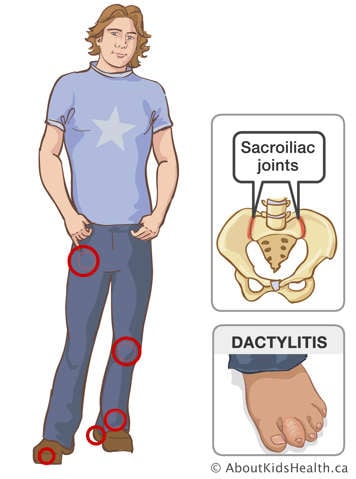Enthesitis (say: en-the-si-tis)-related JIA involves inflammation in both the joints and the entheses, which are the spots where tendons or ligaments attach to bones.
Quick facts about enthesitis-related JIA

Here are a few things you should know about enthesitis-related JIA:
- It occurs in 10% to 25% of young people who have JIA.
- It generally affects children older than eight years of age.
- It is more common in boys than girls.
- The arthritis usually involves joints and entheses in the legs. The hips are often affected.
- Enthesitis is most common around the knees, heels, ankles, and bottom of the feet. Therefore, knee, heel, and foot pain are common with activities.
- Often enthesitis-related JIA will affect the spine and the joints in the lower back and lead to pain and stiffness in the back and neck.
- People with this type of JIA may have swelling in the tendons of the fingers and toes, which may make them look like sausages. This is called dactylitis.
- There is sometimes inflammation of the small joints of the feet, called tarsitis.
- The joint inflammation of enthesitis-related JIA often lasts into adulthood.
- Enthesitis-related JIA may be associated with inflammation of the skin, eyes, or bowels.
- Many young people with enthesitis-related JIA carry a protein called HLA B27 on their cells.
Enthesitis-related JIA can vary in severity. Some young people may have mild joint and tendon pain every once in a while. Others may have flares that cause pain and trouble walking. A small number of young people with enthesitis-related JIA may develop serious spine and hip inflammation when they are adults. This condition is called ankylosing spondylitis. Treatment depends on the severity of the disease and other complications, and can involve DMARDs and biologic medications.






